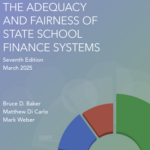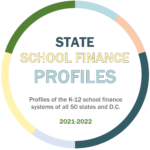Download data
The datasets and resources listed below are all free to download and/or use and are updated annually (with a 2-3 year lag due to the release schedule of federal finance data). They are designed to be accessible not only to researchers, but also to policymakers, parents, journalists, and other stakeholders. Analyses of measures in both datasets can also be found in our annual reports and research briefs.
State Indicators Database
The SID is a dataset of roughly 125 state-by-state school funding measures for each state between 1993 and 2022 (not all variables are available in every year). It includes variables for assessing, between and within states (by district poverty level): the adequacy of spending levels; the fairness of state and local spending and revenue (whether poorer districts receive more resources); state “fiscal effort” (how much of states’ economic capacity is devoted to education); resource allocation (e.g., teacher pay, staffing ratios); and more.
- Download the SID User’s Guide: a list of all the variables in the database, along with descriptions of the measures and other information (including sources and methods)
- Download the full SID dataset in Excel format
- Download the full SID dataset in Stata format
- Use our online data visualization tools: view one-page state profiles or visualize key SID measures (effort, statewide adequacy, equal opportunity, progressivity, and teacher pay competitiveness)
District Cost Database
The DCD is a district-level dataset of K-12 spending adequacy in roughly 12,000 public school districts in each year between 2009 and 2022 (the updated DCD is typically published within a few months after the SID). For each district/year, the dataset allows users to assess adequacy by comparing actual per-pupil spending with estimated adequate spending per pupil (defined as spending required for the district to achieve the common “benchmark” of national average test scores). These estimates, which are also used to construct the adequacy measures in the State Indicators Database, are from our SFID National Education Cost Model (for more details about the model, see the user’s guide). The DCD, which can be merged into other datasets using NCES district identification numbers, also includes a small group of variables measuring district characteristics, such as testing outcomes, enrollment by race/ethnicity, and Census poverty rates.
- Download the DCD user’s guide: A list of all variables in the District Cost Database, along with a brief description of the measures and methods
- Download the full DCD dataset in Excel format
- Download the full DCD dataset in Stata format
- Use our DCD online visualization tool: select a district to display a profile of spending adequacy and other measures in that district
The underlying data sources and methods for all of our measures are listed in the user’s guides. We recommend that users review this documentation and data use agreements contained therein.
Latest News
 UPDATED ANNUAL REPORT, PROFILES, AND DATASETS AVAILABLE
UPDATED ANNUAL REPORT, PROFILES, AND DATASETS AVAILABLE
March 2025: Read the seventh edition of our annual report, view your state’s one-page finance profile, use our data visualizations, or download the full state- and district-level dataset.
Latest Annual Report
 The Adequacy and Fairness of State School Finance Systems (7th edition)
The Adequacy and Fairness of State School Finance Systems (7th edition)
The seventh edition of our annual report presenting findings on effort, statewide adequacy, and equal opportunity in state school finance systems. Published March 2025.
Latest Research Briefs
 State School Finance System Profiles (2021-22 school year)
State School Finance System Profiles (2021-22 school year)
One-page profiles summarizing the key results on effort, statewide adequacy, and equal opportunity for all 50 states and D.C. View your state’s profile. Published March 2025.




